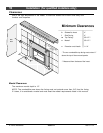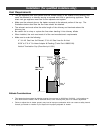
12 Installation (for qualified installers only)
© Travis Industries 4060111 100-01174
Gas Line Requirements
MASSACHUSETTS INSTALLATIONS - WARNING:
THIS PRODUCT MUST BE INSTALLED BY A LICENSED PLUMBER OR GAS FITTER WHEN INSTALLED WITHIN THE
COMMONWEALTH OF MASSACHUSETTS.
OTHER MASSACHUSETTS CODE REQUIREMENTS:
• Flexible connector must not be longer than 36 inches.
• Shutoff valve must be a “T” handle gas cock.
• Only direct vent sealed combustion products are approved for bedrooms or bathrooms.
• Fireplace dampers must be removed or welded in the open position prior to the installation of a fireplace insert or gas log.
• A carbon monoxide (CO) detector is required in the same room as the appliance.
• The gas line must be installed in accordance with all local codes, if any; if not, follow ANSI 223.1 and the
requirements listed below.
• A manual shutoff valve is required within 3’ of the heater. It should be placed upstream of the flex line (if
used) and may be installed behind the access door inside the heater. ).
• The heater and gas control valve must be disconnected from the gas supply piping during any pressure
testing of that system at test pressures in excess of 1/2 psig. For pressures under 1/2 psig, isolate the
gas supply piping by closing the manual shutoff valve.
• Leak test all gas line joints and the gas control valve prior to and after starting the heater.
• This heater is designed either for natural gas or for propane (but not for both). Check the sticker on the top
of the gas control valve to make sure the correct fuel is used (see illustration on page 4).
• Installation must be performed by a qualified installer, service agency or the gas supplier (In Massachusetts
a licensed plumber/gasfitter).
Gas Line Location
The gas inlet
accepts a 1/2" MPT.
3-1/8"
Shutoff Valve (secured to
the fireplace insert)
Fireplace Opening
Gas Inlet Pressure
Standard Input Pressure
Natural Gas 7" W.C. (1.74 kPA)
Propane 13" W.C. (2.73 kPA)
• If the pressure is not sufficient, make sure the piping used is large enough, the supply regulator is
adequately adjusted, and the total gas load for the residence does not exceed the amount supplied.
• The supply regulator (the regulator that attaches directly to the residence inlet or to the propane tank) should
supply gas at the suggested input pressure listed above. Contact the local gas supplier if the regulator is at
an improper pressure.


















